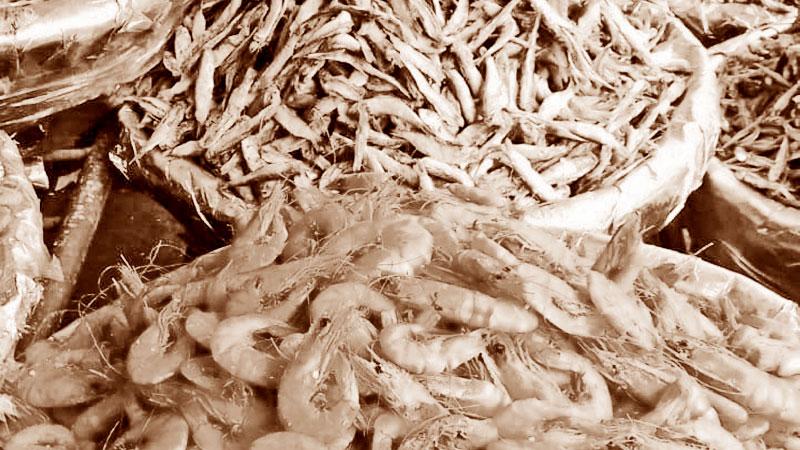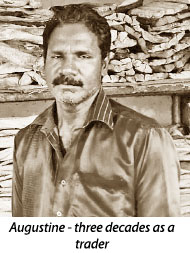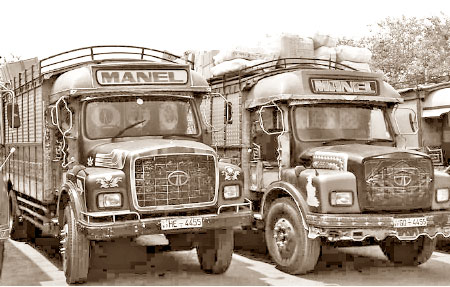
The bazaar in Colombo 11 extends to cover many cross roads. In this crowded domain of enterprising traders you can find almost anything. To those of us who relish our rice and curry, a serving of dried fish deep fried would certainly enhance our spicy indulgence. On a previous occasion I have written about the dried fish industry in Negombo, but the dried fish traders on Keyzer Street represent the produce from every coastal region of Sri Lanka, and some parts of Asia!
 A long row of shops down Keyzer Street (entered via the People’s Park side of the Pettah) gives you a glorious view of an assortment of dried fish. One of the first shops on this stretch belongs to Augustine, a man in his early fifties. Images of Catholic saints adorn the topmost shelf of his shop, loaded with dried fish neatly arranged on wooden racks.
A long row of shops down Keyzer Street (entered via the People’s Park side of the Pettah) gives you a glorious view of an assortment of dried fish. One of the first shops on this stretch belongs to Augustine, a man in his early fifties. Images of Catholic saints adorn the topmost shelf of his shop, loaded with dried fish neatly arranged on wooden racks.
Augustine explains, “I came to Colombo almost 30 years ago from Trincomalee. Keyzer Street is now my second home. We have been engaged in selling dried fish which we get from all parts of the island, as well as from India, Pakistan and Indonesia”. The prices of the dried fish per Kg are displayed as follows: Sprats at Rs 550, Balaya, Rs 600 and coonie isso (very small prawns) at Rs 550. Maldive fish seems to fetch a better price of Rs 1,100 (per Kg) with dried seer fish fetching Rs 1,280 (per Kg). Augustine opines, “People’s eating habits change. But thankfully our sales remain stable. Our top seller is the katta variety of dried fish”.
The street is busy with labourers unloading crates and baskets of dried fish from lorries approaching from Jaffna, Mannar and Negombo. The nattami (labourers) skillfully navigate their wooden carts, with the dried fish crates balancing precariously. Crows hover around in this area in earnest expectation.
Another shop that has been in business for decades is Livingstone Stores. The manager, Rosairo Fernando was busy checking an invoice.
 Lorries that travel cross country |
He motioned me to enter, and explained, “Dried fish can be cooked in many forms, perhaps, even better than fresh fish. It gives back its natural flavours.
Our top products are the dried prawns. These prawns come from Navanthurai in Jaffna.
The prawns are washed, then boiled, during which process they turn orange in colour. Salt is then rubbed by hand. Our fresh stocks come every other day from Jaffna”.
Rosairo asked one of his assistants to take a portion of “kiri mora” or (paal sura, in Tamil). This dried fish is given to breast feeding mothers, as it is supposed to enhance the quality of milk (thus the term paal sura, - paal meaning milk in Tamil). The ‘kiri mora’ is in demand, and as we talk, a pregnant lady comes and makes a large purchase.
The red prawns make their way into top restaurant menus. The smaller coonie isso will definitely enrich a spicy roasted coconut sambol. It was interesting to observe how our lifestyles influence our eating choices.
Many female friends living in modern condominiums confessed that they felt ‘embarrassed’ to fry dried fish in their apartments, assuming that the pungent smell would permeate the neighbour’s homes. Some others were conscious that the ‘extra’ salt in the fish might elevate their husband’s already high blood pressure levels. Leaving this fallacy aside most Sri Lankans cherish their dried fish, either curried, tempered or fried, especially those domiciled overseas and are here on holiday. The traders down Keyzer Street will continue to feed our intimate culinary indulgence for many more years to come.
